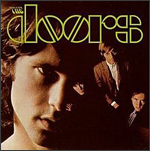| Music | Literature | Film | Index | About |

|
The Doors, The Doors Elektra Records, January 4, 1967 Track Listing: 1. Break On Through (To the Other Side), 2. Soul Kitchen, 3. The Crystal Ship, 4. Twentieth Century Fox, 5. Alabama Song (Whisky Bar), 6. Light My Fire, 7. Back Door Man, 8. I Looked at You, 9. End of the Night, 10. Take It As It Comes, 11. The End See also: Strange Days, October 16, 1967
“Strange days have found us -from “Strange Days” The recent obituary for keyboardist Ray Manzarek stated that The Doors were bordering on shamanistic. There was no bordering about it. Jim Morrison, the lead singer, was an unbridled shaman but like the rest of us completely self-taught in the realm of altered states of consciousness. We were all self-initiated. We were treading on holy ground and we had absolutely no idea what we were doing there. We were day-tripping in the spirit world with nary a tour guide in sight on either side of the great divide. “Made the scene -from “Break On Through (To the Other Side)” Every night as youngsters while we watched TV we were advised that we all could have “better living through chemistry.” It’s not much of a stretch to thinking that instant enlightenment could be had by merely throwing open the doors to the pharmacological cabinet of visions and dreams. So they named themselves The Doors. And they blew the minds of anyone that opened their door to them when they came knocking. The Doors played three concerts in Chicago within 13 months at three different venues. My beautiful soul mate and I went to all three. And we witnessed firsthand the rise and fall of the Lizard King. As the quality of venue of each concert improved, the drinking and decline of the singer metastasized and within a few years he would die peacefully of a drug overdose in Paris in a self-imposed exile from rock and roll and performing live. “Time to live -from “Take It As It Comes” We were still basking in the glow of the previous summer’s love when in early May of 1968 The Doors visited Chicago for the first time. They played the Coliseum, a decrepit venue that had been built on the foundation and some remnant stone walls that remained from the brick by brick reconstruction and subsequent demolition of the former Confederate prison, Camp Libby. It was brought from Virginia to Chicago as some sort of bizarre museum. Or it could have been a civic sleight of hand to distract the populace from the real horror show that had taken place just down the street at Camp Douglas, a Union prisoner of war camp for captured Confederate soldiers. Imagine for a moment soldiers from the deep south experiencing a Chicago winter in an overcrowded, disease-ridden camp and you’ll understand why somewhere between 5,000 and 6,000 prisoners died. No one knows the exact number. The fact that the camp was built to hold 10,000 but was overburdened with as many as 26,000 prisoners was real. As a result Camp Douglas had more deaths than any of the other 150 Union prison camps holding Confederate soldiers during the war. After the camp closed the dead were disinterred and reburied in the largest mass grave in the Western Hemisphere in Oak Woods Cemetery in the Woodlawn neighborhood on Chicago’s South Side. But as usual I digress. The Doors arrived at the Coliseum at the height of their powers and Morrison wanted to see if he could get a riot started. The Coliseum was the perfect site for the shaman’s ultimate rock and roll experiment. The band began playing and he burst onto the stage like a demon from another world screaming into the first song. The experiment was already a raving success. The audience also played their part perfectly. Waves of energy rippled through the crowd, and beyond feeling it, you could actually see it. We had tapped into something strange and there was no turning back. We were seated on the main floor but we quickly decided to go sit in the side balcony to get away from the weird vibrations pulsing through the crowd and we had a better view looking down at the stage as well. It turned out to be a very good decision because one of the fans decided to swan dive off of the balcony landing about where we had been seated and a riot of sorts broke out on the main floor. “You know the day destroys the night -from “Break On Through (To the Other Side)” Raise the spirits, tear down the walls, break out of the camp, freedom awaits. Could the thousands of rebel soldiers who died during their internment be awakened 100 years later by some over-amplified sonic shamans promoting a message of rebellion, physical and spiritual freedom, and sexual ecstasy? What spirit, mortal or ghost is not signing up for that? And how many tortured, incarcerated souls would not hesitate to use the occasion as another chance for resurrection? “Cancel my subscription to the Resurrection -from “When the Music’s Over” Perhaps the waves of energy we witnessed were extraneous spirit vibrations trying to cross from one realm to another. The transmuted souls of the Rebel dead urged the crowd on but the real rebellion would begin four months later several blocks away in Grant Park when the Chicago police would riot and finally turn the entire country against the Viet Nam War. By late August there wasn’t any doubt that the Summer of Love was definitely over. The 1968 Democratic Convention killed any lingering feelings that Love would save the world. Throughout history most revolutions started with street protests, but this was mid 20th Century Amerika. The rumors along the barricades were that The Doors were on their way to Chicago. This was going to be the first revolution in history to be ushered in with a soundtrack by a popular rock and roll band. Of course it was just idle talk. “I hear a very gentle sound -from “When the Music’s Over” The Doors did eventually appear at the site of the Democratic Convention, but only to pick up a paycheck, as they were a couple of months too late to participate in any of the street protests. This show was held at the International Amphitheatre located in the Chicago Stockyards and was essentially a big barn for livestock shows. It was also another site of mass killings however not of the human kind. It was where Chicago had become the hog butcher of the world. In the preceding hundred years over a billion animals showed up in livestock railroad cars, were processed in a Ford-like disassembly line and sent back out to a hungry nation in refrigerated railroad cars. The Amphitheatre show still had some of the fire that burned white-hot at the Coliseum but it was more controlled and not so much from within The Doors as from the outside. By now police departments everywhere were looking to lock up The Doors for whatever perceived transgression that they could invent. The establishment didn’t like the message of revolution and sexual freedom. And also like many of the great musicians of the late ’60s the excessiveness of living and performing on the edge with the crowds demanding ever greater displays of personal power was starting to take its toll. We just didn’t want to see genius burning brightly, we wanted to see it explode like a nova. Instead of an explosion, the last show we attended at the Auditorium Theatre was like a firecracker that fails to ignite after the fuse sparkles and sputters. The Auditorium Theatre had just been restored to its original opulence six months before The Doors arrived. Designed by two masters of American architecture, Louis Sullivan and Dankmar Adler the acoustically perfect Auditorium Theatre was considered ahead of its time. It is the greatest auditorium ever built for music or opera. Not only is it the best room to hear rock and roll, there isn’t a bad seat in the entire house. It is also breathtakingly beautiful in its detail. Everything else about the show was wrong. A Chicago AM radio station sponsored the concert. It was the last gasp of AM rock and roll radio trying to remain relevant as the underground sounds of FM radio were shooting past all the top 40 AM rock stations in popularity. What were the station managers thinking, didn’t they remember what the first concert was like? Didn’t they remember what the police presence was like at the second concert? The hapless DJ made the introduction. In just over a year’s time the Lizard King went from leaping on stage with a primal scream to hanging onto the microphone stand seemingly asleep, clutching a can of Budweiser, while the rest of The Doors continued to play the intro. Finally after what seemed to be an incredibly long time Morrison came back to life and began singing. It was as if after being restored the theatre’s magnificence overshadowed the shaman’s brilliance. But that was not the case. The shaman began to lose his power because being self-taught he had no idea how to conserve it. He was giving it away in increasing doses to the star making machinery. And the star was beginning to flicker. It would not be long before it would burn out forever. “This is the end -from “The End” The Doors came to Chicago once more in February of 1970 and played the Amphitheatre again, but we didn’t bother to go. We were afraid that the first concert would be further tarnished and I didn’t want that to happen. The bar had been set so extremely high by the first concert that it was impossible for the band to top it. I didn’t realize at the time that the music was already beginning to transcend the music makers. That incredible first show remains one of the best concerts I have ever witnessed. It became the standard by which I judge the intensity of all subsequent rock and roll bands and their performances. “When the music’s over -from “When the Music’s Over” I check into The Doors catalog every so often and always marvel at their incredible synergy. The philosophical distance between performer and audience wasn’t so great back when these albums were released. It was one of the few times in the history of rock and roll that the audience and the band were one and the same. They remain one of my favorite bands of all time. So much happened so quickly in the months between the shows that it has taken years to make sense of the political and social changes that occurred in our culture. The 1960’s version of rebellion was just a bit tamer and more comfortable and a hell of a lot more fun than the 1860’s version, but was no less important in the sweep of history. They were indeed strange days.
|
 |
||||||